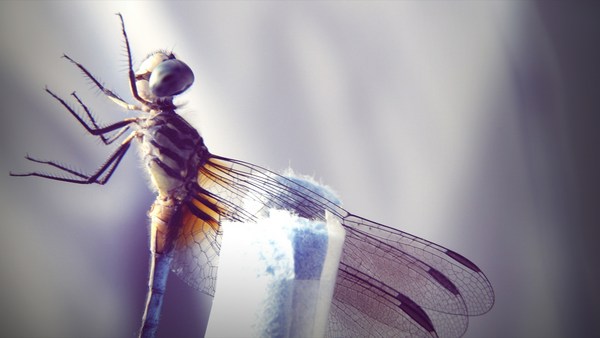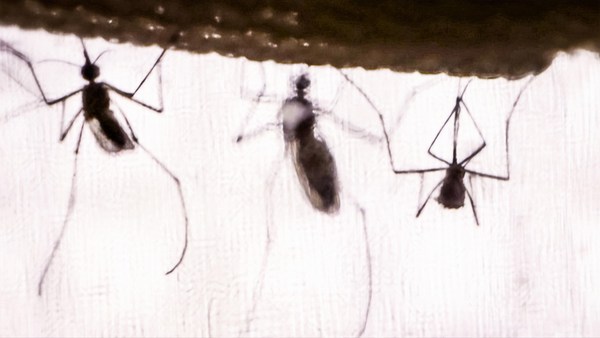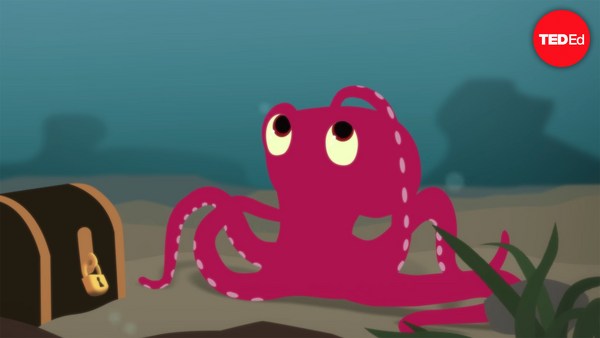Greg Gage: The octopus is a rather strange-looking animal that exhibits amazingly complex behaviors. They have the most impressive nervous system in the entire invertebrate world. They have about a half a billion neurons that are distributed throughout their body, such that two-thirds of the neurons are actually in its legs. Now mix this in with camouflaging cells, jet propulsion and a razor-sharp beak, and you have all the makings of a formidable predator. And then throw in the fact that the octopus is a solitary creature, and suddenly, we have ourselves a real cephalopod fight.
(Bell)
[DIY Neuroscience]
We know that almost all animals fight -- for food, for territory, for mates. The octopus is no different, and knowing their fighting behavior could help us better understand these fascinating creatures and how they interact. My friend Ilya has been observing the classic fighting behavior between California two-spot octopuses.
Ilya Chugunov: Most people think that it's "octopi," but that's actually incorrect. The correct plurals are either "octopuses" or "octopodes" if you want to be very Greek about it.
GG: So how do you do your experiment?
IC: First, I like to set up the chamber just so it's ready, so I get a jug of water, I aerate it by shaking the jug. It seems that if the water is well-aerated, they're a lot more active. This gives the octopuses some room to breathe. I get the first octopus -- Here, buddy. Here, pal. Put it in, set up my GoPro, put the second octopus in, cover it up and leave it alone.
(Bell ringing)
Rule 1: There's always an aggressor.
There's always one octopus on defense, one on offense. Usually the one that's taking up more space, that's more boastful, definitely the aggressor, most likely the winner of the fight. The loser's pretty obvious. They get pushed around, they curl up, hide in a corner. A lot of the time, when there's initial contact, if one of them is too much on the defensive side, the second one will sort of poke at it, grab at its tentacle and see, "Hey, do you want to fight me, do you want to turn around? Do you want to start a wrestling match?" So it'll just poke and run away. Come back, poke and run away.
(Bell ringing)
Rule 2: Avoid eye contact.
When the octopuses come towards each other to begin the fight, they don't actually face each other. They approach sideways. The defensive octopus tries to face away from the attacker until it's the critical moment it knows there's no way to avoid a fight.
GG: Really, the one who's waiting to the last moment is the defensive octopus.
(Bell ringing)
Rule 3: Flash your colors. The aggressor in a fight will quickly and sharply flash bright black on his arms when he's about to initiate a fight.
(Bell ringing)
GG: Ooh, and already --
IC: We're seeing some action. Looks like they've spotted each other.
GG: Right. So now he's going to come -- He's approaching, but not directly at him.
IC: Yeah, they're like almost completely antiparallel.
GG: And then right there --
IC: Yeah. They contact, and then their arms clash together.
(String music)
GG: So we've taken the first steps in understanding fighting in the octopus. And you might be asking yourself: Why does this even matter? Well, these types of curiosity-based research questions can often lead to some unexpected insights and discoveries. We've learned a lot about ourselves from studying marine animals. Squid have taught us about how our neurons communicate, and the horseshoe crab has taught us about how our eyes work. So it's not too far of a stretch to say that some of these behaviors that we're seeing in the California two-spot octopus are similar to ours.





